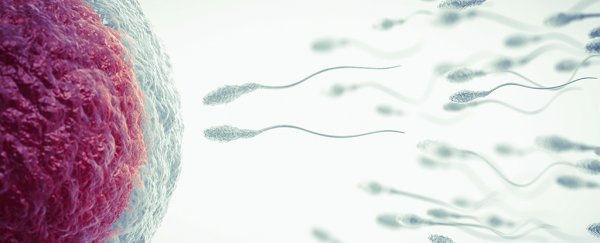A brother and sister born in Australia in 2014 have joined an exclusive club of siblings who share an extremely rare bond - they are the second pair of 'semi-identical' twins ever found.
The twins each received a jumble of DNA from dad, but the genes they've inherited from mum are 100 percent identical. Not only is there only one other such case known, but this pair were the first to be detected before they were born.
"The mother's ultrasound at six weeks showed a single placenta and positioning of amniotic sacs that indicated she was expecting identical twins," says foetal medicine specialist Nicholas Fisk, who looked after the young family while based at Royal Brisbane and Women's Hospital four years ago.
"However, an ultrasound at 14 weeks showed the twins were male and female, which is not possible for identical twins."
Typically speaking, twins come in just two varieties. There's the non-identical 'dizygotic' sort, which are the result of two ova each fertilised by a separate sperm.
Then there are those who are identical, or 'monozygotic', where a solitary fertilised ova divides completely into distinct individuals before settling into its expected program of growth and foetal development.
Before 2007, the very idea of a third 'sesquizygotic' category was more theoretical than established fact. Then came a random discovery of twins born in the US who proved to be genetic chimeras.
Both of those infants possessed a mix of cells, some with two X chromosomes and others with a Y chromosome. If one of the infants hadn't been born intersex, it's possible we'd be none the wiser to their genetic secret.
Similarly, while neither of the Australian twins physiologically present as intersex, both have an assortment of cells carrying either XX or XY chromosome pairs.
Testing of cells taken from their respective sacs of amniotic fluid also showed that while the maternal DNA of each was 100 percent identical, only 78 percent of the paternal DNA matched.
One possible explanation for this assortment of genomes in a single person is that the mother's ova may have prematurely copied itself prior to being fertilised by two sperm, but didn't fully separate.
There is another possibility, one favoured by the specialists investigating the most recent case.
"It is likely the mother's egg was fertilised simultaneously by two of the father's sperm before dividing," says Fisk.
Like that friend who's tagging along on a first date, an extra selection of genes should spell disaster for any budding romance, meaning such a newly fertilised embryo usually wouldn't be expected to make it.
"In the case of the [Australian] sesquizygotic twins, the fertilised egg appears to have equally divided up the three sets of chromosomes into groups of cells which then split into two, creating the twins," says clinical geneticist Michael Gabbett from Queensland University of Technology, Australia.
With so few examples to go on, it's hard to know for certain which explanation is more accurate, or if each set of twins developed in slightly different ways.
It's also difficult to estimate how many twins thought to be non-identical actually share the same selection of their mother's DNA.
An investigation of global databases on twins suggests if there are others out there, they're still incredibly rare examples.
"We at first questioned whether there were perhaps other cases which had been wrongly classified or not reported, so examined genetic data from 968 fraternal twins and their parents," says Fisk.
"However we found no other sesquizygotic twins in these data, nor any case of semi-identical twins in large global twin studies."
Such rarity rules out any case for routine genetic screening for chimerism in twins, at least for now.
Advances in genetic screening and expanding databases of medical data could lead to the discovery of more semi-identical twins in the future, however, and possibly help us better understand the fertilisation process in better detail.
In the meantime, these sets of twins can legitimately claim to be just two of a kind.
This research was published in The New England Journal of Medicine.
